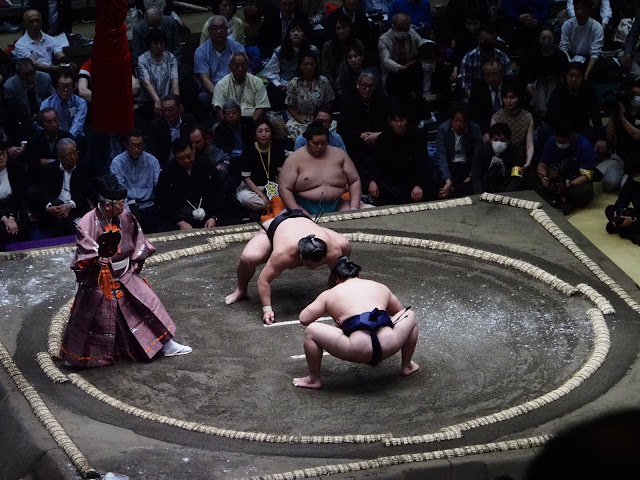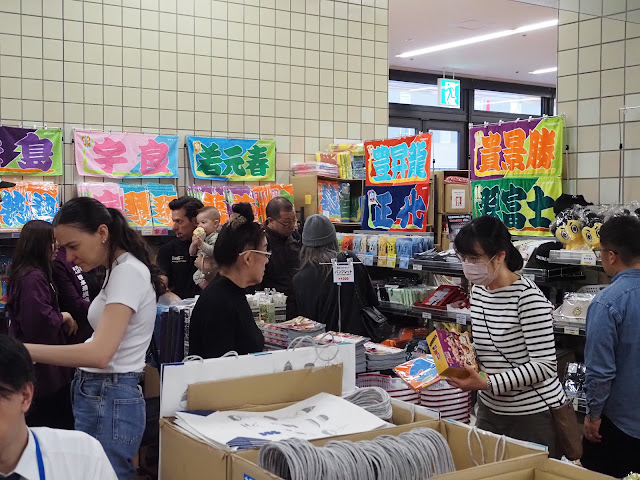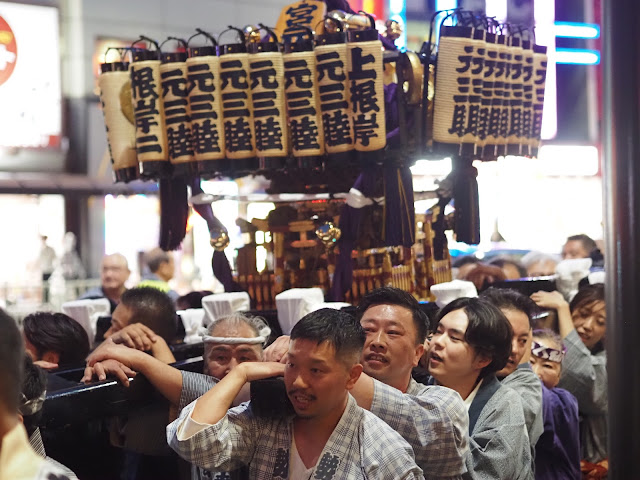Sumo
When I arrived at the Grand Sumo Tournament on Day 2 of the 15-day extravaganza, the crowd was still buzzing about Terunofuji's shocking loss and withdrawal on Day 1.
So it should be an exciting two weeks. Anyone can win it, but I assume Hiradoumi, 27, is the presumptive favorite.
Yes, I'm into sumo now.
There is a stable (heya) called Fujishima 200 meters from where I type this. One of its wrestlers, Bushozan, competed tonight in the Juryo (intermediate) division.
Only 600 to 700 wrestlers are ranked in professional sumo. Almost all of them join a heya at 15 after they finish junior high. (There is no mandatory schooling in Japan after that.)
It's like joining a monastery. Your new parents are your stable master and his wife.
The intermediate-division wrestlers are kids. I see them occasionally in the neighborhood in which I am lodged, sometimes at the laundromat.
If you win enough matches, you can move out of your heya, get married and have a lower-ranked rikishi carry your belongings to the venue on match day. It's a high-pressure life.
This prestigious tournament, one of two annually in Tokyo, takes place at the octagonal Ryogoku Kokugikan, which seats 11,000.
If you've seen the James Bond movie "You Only Live Twice" (1967), you know the spot.
At 3:40 p.m. the senior-division (Makuuchi) wrestlers are introduced. They form a vivid circle in decorative dress and turn to face the crowd. Hardwood sticks called hyoshigi are clapped together to get the audience's attention.
People in the crowd shout out their favorite wrestlers' names.
The rules of the sport are easy to understand. A sumo wrestler is called a rikishi.
Two rikishi battle in a ring 15 feet in diameter.
Two starting lines are painted on the east and west sides of the ring. The rikishi start from a crouched position. Usually they have one or both fists on the ground, but not always.
They are required to begin the match at the same time, though there is no starting indication from the referee, known as the gyoji.
The initial clash at the beginning of a sumo match is called the tachiai. It literally translates as "stand and join."
From here, a match can two ways. The eventual winner will either 1.) thrust his opponent out of the ring quickly or 2.) grab his mawashi (belt), and use it to mess with his center of gravity and leverage him out of the ring.
The second tactic is considered ideal. If your opponent grabs your belt, kiss your match goodbye.
Interestingly, you don't have to be tossed out of the ring to lose. If any part of your body touches the ground inside the ring (other than your feet), you're done.
It's a surprisingly violent sport, with slaps to the face, thrusts to the throat, sometimes even elbows to the head. These are all legal.
The only illegal moves in sumo are hair-pulling, eye-gouging, punching and biting. It's rare for a rikishi lose a match via disqualification. When it does happen, it's usually an accidental hair pull.
Here's an important bout late in the evening. Can you tell who wins it?
Up until now I thought the gyoji didn't have much to do, but he instantly motions that the wrestler who flew into the crowd won the match. Major League Baseball could use him.
Some other insights as the night progresses: A deity is thought to live in the circle, so the rikishi toss salt into the ring to purify it.
Banners paraded around the ring before a match indicate prizes offered to the wrestlers. The more banners, the more compelling the contest is.
I learned a lot about my camera tonight. Most of these sumo matches last 1 to 6 seconds. Here is a contest in seven frames. (Context: I am in the second-to-last-row, near the ceiling.)
At the souvenir shop, you can buy towels with the name of your favorite rikishi and hold it up when he enters the ring. There is also a snack bar that sells tallboys of beer.
As the night wears on, tension increases. The top fights are between 5:15 and 6 p.m.
Here is the longest (9 seconds?) and most intense match of the evening.
The audience goes crazy. It is followed by an announcement of the next fight.
The lady in the yellow lanyard has been so fun to watch. She is intensely immersed in the experience and is having the time of her life. In the second bout she gets a 420-pound wrestler in her lap and couldn't be happier.
I hope this gives you a good sense of a sumo tournament's pace and atmosphere. Notice the head games preceding the tachiai in the second fight.
Marking the end of the evening is a bow-twirling ceremony to drive away evil spirits from the circle.
After spinning the bow, the rikishi symbolically digs into the ground to drive away demons in the ground.
Then he stomps, and the crowd goes nuts, yelling "yossha!" Which I think means "awesome!" or "you betcha!"
And then everyone stands up to go home, and a sea of umbrellas presses toward Ryogoku Station.
I break off from the crowd and walk an hour in the rain, stopping for a sake to think about where I rank tonight on my all-time list of live sports experiences.
Top 5?




















Comments
Post a Comment